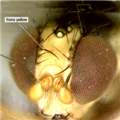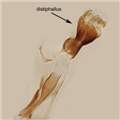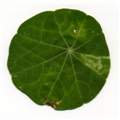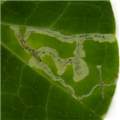
head (M. Malipatil)

aedeagus (A. Ames)

mine on Tropaeolum majus (P. Ridland)

mine on Tropaeolum majus - close up (P. Ridland)
Nomenclature
Liriomyza brassicae (Riley 1885)
Oscinis brassicae Riley 1885Liriomyza cruciferarum Hering 1927Phytomyza mitis Curran 1931Liriomyza hawaiiensis Frick 1952Liriomyza bulnesiae Spencer 1963Liriomyza ornephila Garg 1971
Common name: cabbage leafminer
Hosts
Spencer (1973, 1990) noted that L. brassicae has been recorded from 16 genera in the Brassicaceae, Capparaceae, Resedaceae and Tropaeolaceae. It has also infrequently been recorded in the Fabaceae [Pisum (Kleinschmidt 1970; Spencer 1973) and Lathyrus odoratus (Lardner 1991)]. In Australia, detailed field surveys have recorded L. brassicae from 13 genera of Brassicaceae, 2 genera of Capparaceae, one genus of Tropaeolaceae (Tropaeolum majus) and two genera in the Fabaceae (Kleinschmidt 1970; Lardner 1991; Spencer 1963a).
Distribution
Asia: Cambodia, China, India, Indonesia, Iraq, Japan, Malaysia, Philippines, Singapore, Sri Lanka, Thailand, YemenEurope: Germany, Malta, SpainAfrica: Cape Verde, Egypt, Ethiopia, Kenya, Mozambique, Senegal, South Africa, ZimbabweNorth America: Canada, USASouth America: Argentina, Brazil, Guyana, VenezuelaOceania: Australia (Australian Capital Territory, New South Wales, Queensland, South Australia, Tasmania, Victoria, Western Australia), Federated States of Micronesia, Fiji, Guam, New Zealand, Northern Mariana Islands, Papua New Guinea
Based on data from Crop Protection Compendium (2007).
Key characters
Head including antennae bright yellow, scutellum yellow, orbits usually with some darkening, mesonotum shiny black, coxae and femora bright yellow. Third antennal segment small and round. Wing with last section of CuA1 about 3 times length of penultimate section. Aedeagus with distinctive distiphallus. Posterior spiracles of larva and puparium with 3 bulbs.
The species can be easily confused with Liriomyza sativae, particularly in paler specimens where the orbits are not significantly darkened (Spencer 1981). However, the shape of the distiphallus is very distinctive and could not be mis-identified for other Liriomyza species. Detailed descriptions of external morphology, host plants and both male and female terminalia were given by Shiao et al. (1991) and Shiao (2004).
Notes
The larva of Liriomyza brassicae forms a narrow upper surface mine and pupates externally (Dempewolf 2004; Spencer 1977, 1989). In Taiwan, L. brassicae has become less abundant in brassicaceous vegetable crops and is being replaced by L. bryoniae. These two species are easily distinguished by examination of the distiphallus (Shiao et al. 1991).
In South Australia, Lardner (1991) conducted detailed field and laboratory studies of L. brassicae and its key parasitoids, Hemiptarsenus varicornis (Girault) and Opius cinerariae Fischer. In a field survey in Victoria, Bjorksten et al. (2005) found the most abundant parasitoids of L. brassicae to be Closterocerus mirabilis Edwards & La Salle, Hemiptarsenus varicornis and Diglyphus isaea (Walker). In southern Australia, common agromyzids such as L. chenopodii, L. brassicae and Chromatomyia syngenesiae (usually on Sonchus oleraceus) on weeds and other non-crop plants would act as important reservoirs for populations of parasitoids of any invasive polyphagous agromyzids (Bjorksten et al. 2005; Lardner 1991).
References
Bjorksten TA, Robinson M & La Salle J (2005). Species composition and population dynamics of leafmining flies and their parasitoids in Victoria. Australian Journal of Entomology 44: 186-191.
Curran CH (1931). Four new Diptera in the Canadian National Collection. The Canadian Entomologist 63: 93-98.
Crop Protection Compendium (2007). 2007 Edition � CAB International, Wallingford, UK.
Dempewolf M (2004). Arthropods of Economic Importance - Agromyzidae of the World (CD-ROM). ETI. University of Amsterdam, Amsterdam. https://agromyzidae.linnaeus.naturalis.nl/linnaeus_ng/app/views/species/nsr_taxon.php?id=57035&epi=55
Frick KE (1952). Four new Hawaiian Liriomyza species and notes on other Hawaiian Agromyzidae (Diptera). Proceedings of the Hawaiian Entomological Society: 509-518.
Garg PK (1971). Studies on Agromyzidae (Diptera) from the Gangetic Basin. Part V. Descriptions of three new species of Phytomyza Fallkn. Oriental Insects Supplement 1: 247-256.
Hering M (1927). Die Minenfauna der Canarischen Inseln. Zoologische Jahrb�cher, Abteilung f�r Systematik, �kologie und Geographie der Tiere 53: 405-486.
Kleinschmidt RP (1970). Studies of some species of Agromyzidae in Queensland. Queensland Journal of Agricultural and Animal Sciences 27: 321-384.
Lardner RM (1991). Comparative host stage utilization of two parasitoids of Liriomyza brassicae (Diptera: Agromyzidae). PhD Thesis, University of Adelaide. thesis details
Riley CV (1885). The cabbage Oscinis. Annual Report of the United States Department of Agriculture 1884: 322.
Shiao SF (2004). Morphological diagnosis of six Liriomyza species (Diptera: Agromyzidae) of quarantine importance in Taiwan. Applied Entomology and Zoology 39: 27-39. abstract, pdf
Shiao SF, Lin FJ & Lu WJ (1991). Redescription of four Liriomyza species (Diptera: Agromyzidae) from Taiwan. Chinese Journal of Entomology 11: 65-74. pdf
Spencer KA (1963a). The Australian Agromyzidae (Diptera: Insecta). Records of the Australian Museum 25: 305-354.
Spencer KA (1963b). A synopsis of the Neotropical Agromyzidae (Diptera). Transactions of the Royal Entomological Society of London. 115: 291-389.
Spencer KA (1973). Agromyzidae (Diptera) of economic importance. Series Entomologica 9. Dr W Junk, The Hague. 418 pp.
Spencer KA (1977). A revision of the Australian Agromyzidae (Diptera). Special Publication. Western Australian Museum 8: 1-255.
Spencer KA (1981). A revisionary study of the leaf-mining flies (Agromyzidae) of California. University of California, Division of Agricultural Sciences Publication 3273.
Spencer KA (1989). Leaf miners. In Plant Protection and Quarantine, Vol. 2, Selected Pests and Pathogens of Quarantine Significance (ed. Kahn RP). CRC Press, Boca Raton, pp. 77-98.
Spencer KA (1990). Host specialization in the world Agromyzidae (Diptera). Series Entomologica 45. Kluwer Academic Publishers, Dordrecht. 444 pp.
WWW Resources
Liriomyza brassicae in Dempewolf M (2004). Arthropods of Economic Importance - Agromyzidae of the World
Liriomyza brassicae in Ellis WN (2018). Plant Parasites of Europe - leafminers, galls and fungi
Liriomyza brassicae in Martinez M (2007). Fauna Europaea: Agromyzidae. In Pape, T. (ed.) (2007) Fauna Europaea: Diptera: Brachycera. Version 1.3 [128068]
Liriomyza brassicae in Australian Faunal Directory (Agromyzidae compiled by MG Elliott, Australian Museum, Sydney. Updated: 12 Feb 2010)




















